Systems 2 p2
1/98
There's no tags or description
Looks like no tags are added yet.
Name | Mastery | Learn | Test | Matching | Spaced |
|---|
No study sessions yet.
99 Terms
b
What groups of cells are not endocrine type?
a) Pancreatic islets.
b) Hassall's corpuscles.
c) Theca cells and corpus luteum.
d) Interstitial endocrine cells (Leydig).
a
Which of the following skin glands is holocrine?
a) Sebaceous glands.
b) Apocrine glands.
c) Serocrine glands.
d) All of them have holocrine secretion.
a
During the filtration of plasma from the glomerular capillaries to the renal tubule, the Filtered
passes through 3 layers.
a) Capillary endothelium, glomerular basement membrane, podocyte filtration slits.
b) Capillary endothelium, endothelial basement membrane, podocyte basement membrane.
c) Renal tubule, Bowman's capsule, glomerular basement membrane.
d) Podocytes, mesangial cells, collecting duct.
a
What type of epithelium makes the urinary tract impermeable to urine?
a) Transitional epithelium.
b) Cubic stratified epithelium.
c) Ciliated columnar pseudostratified epithelium.
d) Endothelium.
b
What cells form the hematotesticular barrier?
a) Leydig cells.
b) Sertoli cells.
c) Spermatogenic cells.
d) Fibroblasts.
b
What ovarian follicles appear in the image?
a) Primordial.
b) Primary.
c) Secondary.
d) Tertiary.
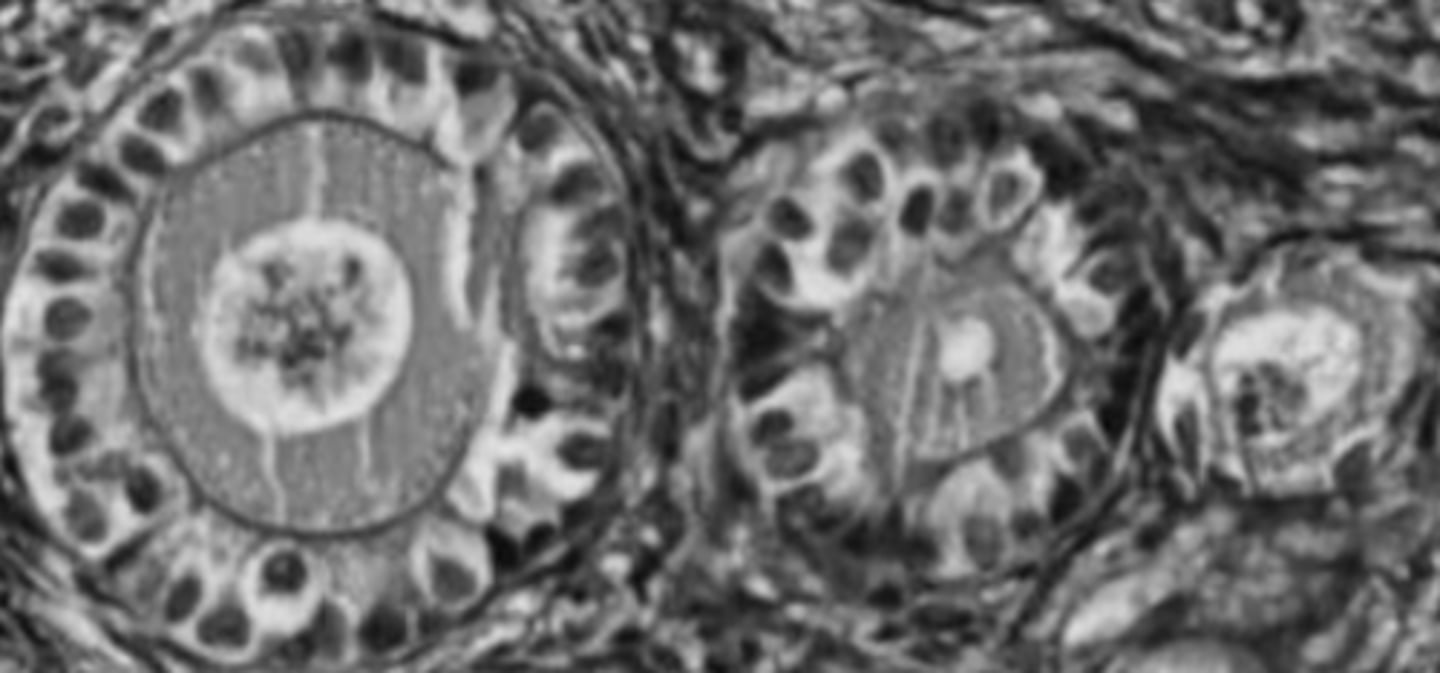
b
Where does the epiphysis localize?
a) Within the cranial cavity, between the cerebral hemispheres.
b) Within the cranial cavity, ventral to the hypothalamus.
c) In the head, but outside the cranial cavity, that is, ventrally with respect to the bones of
the base of the skull.
d) In the cervical portion, near the internal carotid artery.
b
What gland do we observe in the following histological section?
a) Prostate.
b) Thyroid.
c) Parathyroid.
d) Mammary gland.
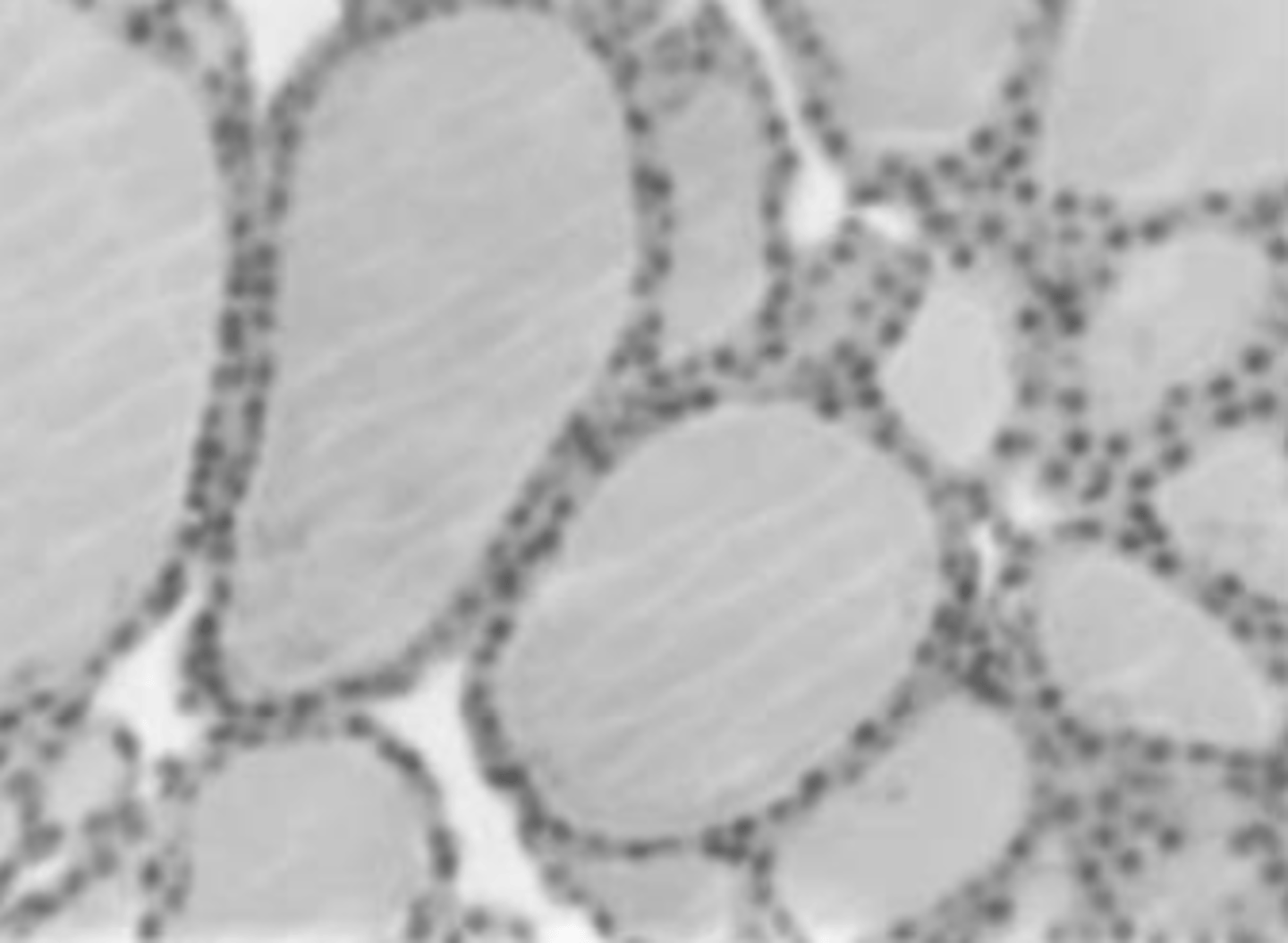
b
What type of follice can be seen in the following image?
a) Primary follicle
b) Secondary follicle
c) Primary
d) Tertiary follicle
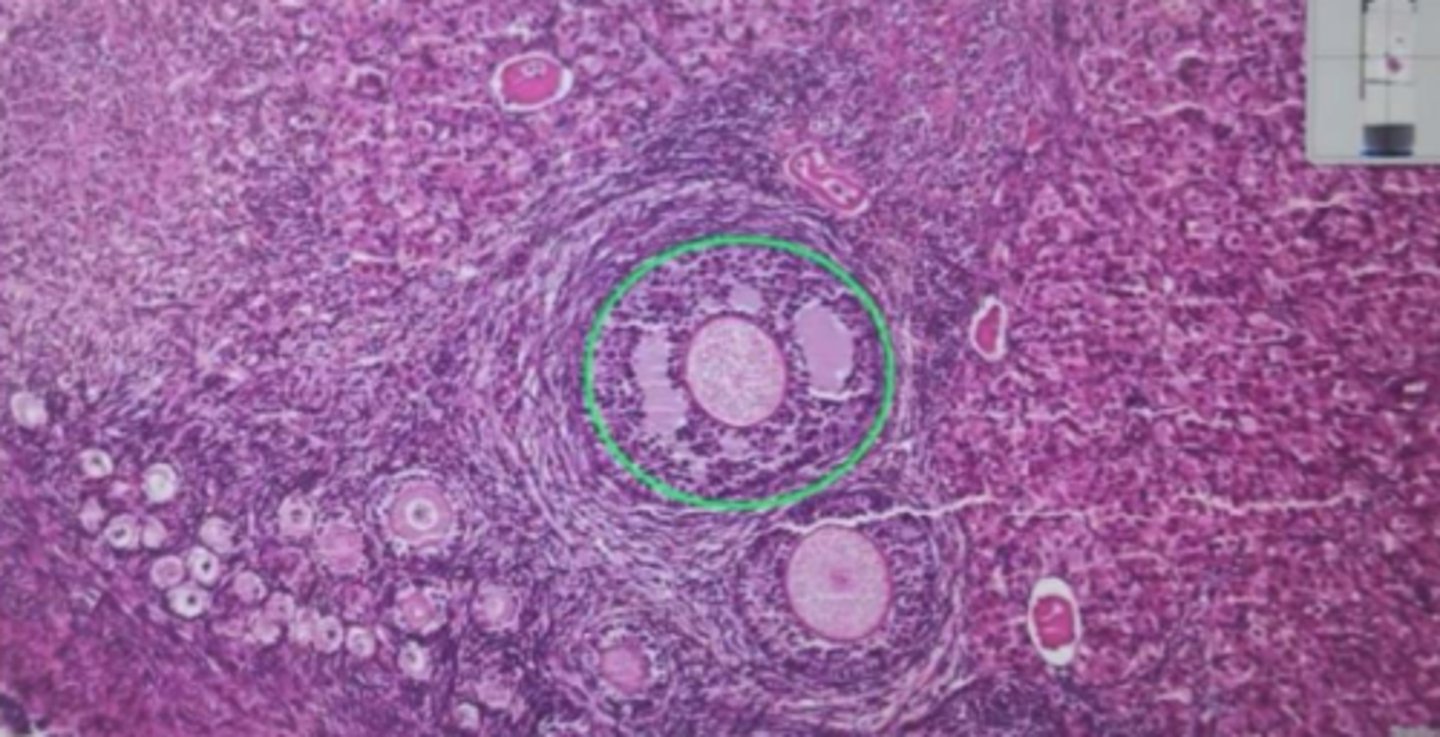
d
The interlobular veins of the kidney:
a) They are parallel to the arcuate veins
b) They are located in the renal cortex
c) They emit afferent glomerular venules
d) They converge into the renal vein
c
Which species has a coagulant gland that produces a mucous plug in the female's vagina after copulation?
a) Rabbit
b) Bird
c) Rodent
d) Iguana
d
What species do these kidneys belong to?
a) pig
b) Small ruminant
c) Cattle
d) Equine
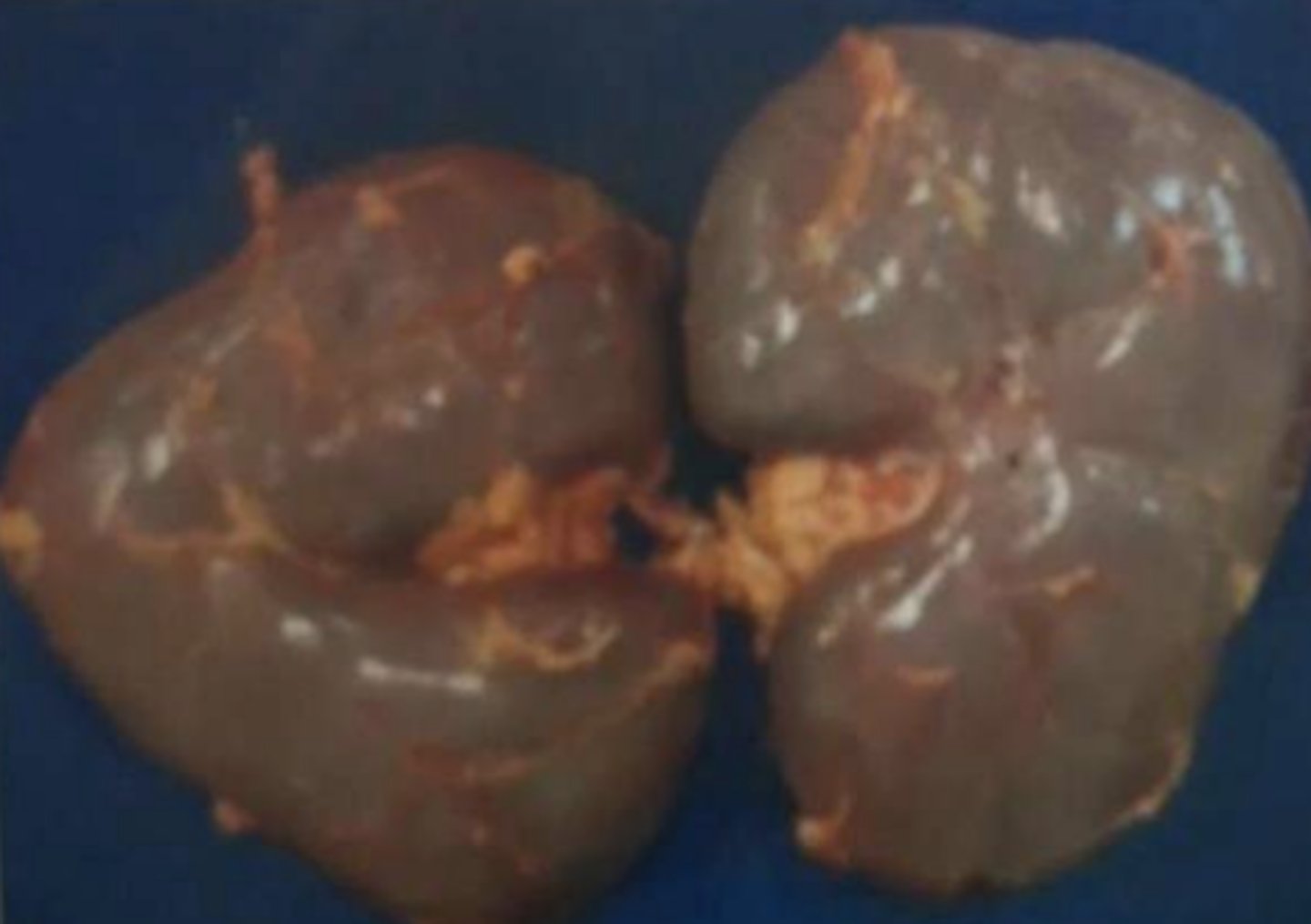
b
Which species has a lobulated kidney?
A) Pigs
b) Cows
c) Small ruminant
d) snake
a
Which species has pluripapillary kidneys?
a) Pig
b) Small ruminant
c) Equine
d) Cow
c
In the hypothalamic-pituitary-gonadal axis in males, mark the correct answer:
a) The hypothalamus releases GnRH which stimulates the anterior pituitary to release
testosterone
b) LH stimulates Leydig cells to produce sperm
c) LH stimulates Leydig cells to produce testosterone
d) FSH is released in the posterior pituitary in response to GnRH
c
Which of the following are water-soluble (hydrophilic) hormones?
a) ADH, T3, glucocorticoids
b) ADH, T3, T4, growth hormone
c) ADH, adrenaline, prolactin
d) ADH, oxytocin, sex hormones
d
Which layer is marked in green in this skin section?
a) Epidermis
b) Dermis
c) None, it is thin skin
d) Hypodermis
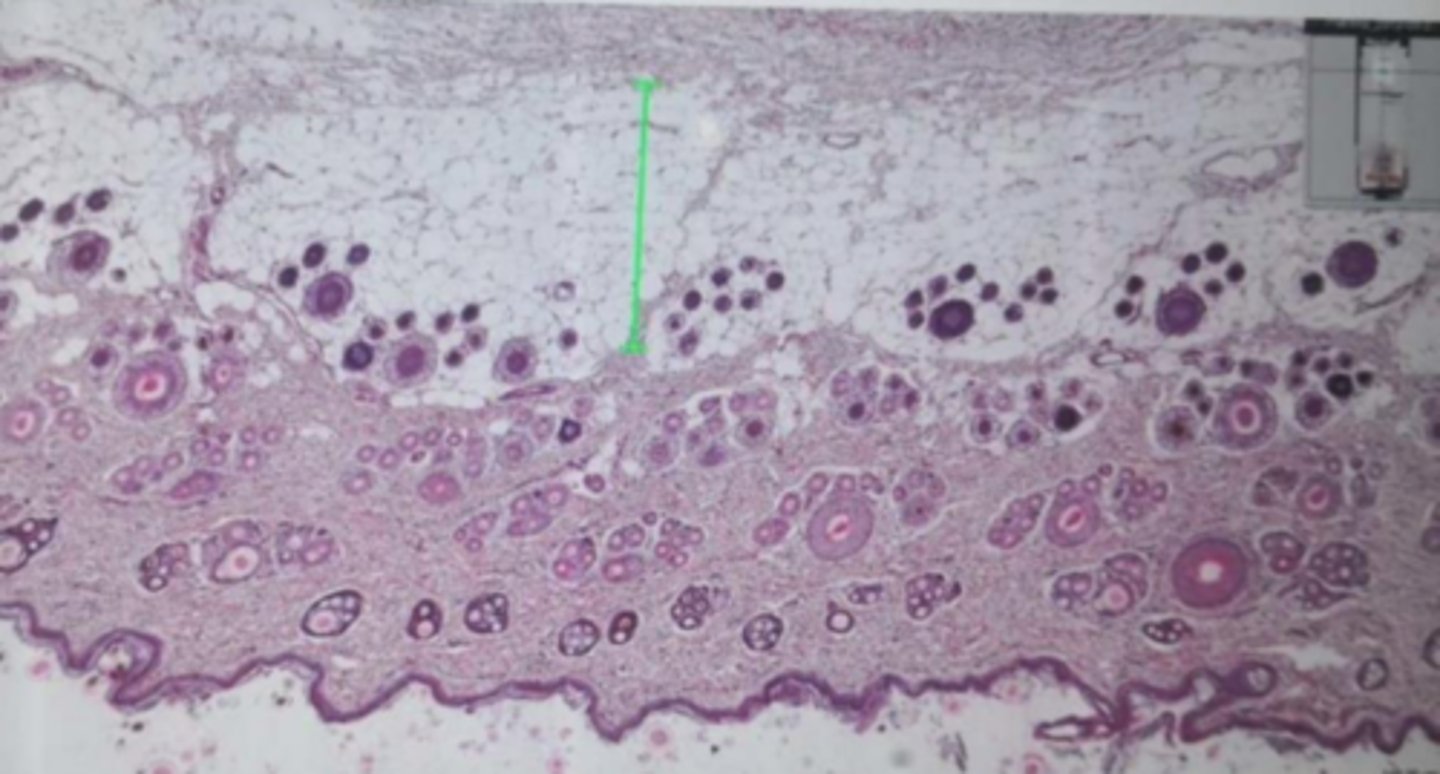
a
What type of epithelium makes the urinary tract impermeable to urine
a) Transitional epithelium
b) Cubic stratified epithelium
c) Ciliated columnar pseudostratified epithelium
d) Endothelium
c
Name the part circled in green:
a) Adenohypophysis
b) Neurohypophysis
c) Pars intermedia
d) Pars tuberalis

a
What is a primary effect of aldosterone?
a) Reabsorption of sodium from urine back into the blood
b) Increased excretion of sodium into the urine
c) Decreased potassium excretion in the kidneys
d) Inhibition of water reabsorption in the nephron
d
What is a correct statement regarding renal blood flow?
a) It is constant regardless of blood pressure changes.
b) It is mainly regulated by hormones from the adrenal cortex.
c) It only increases during dehydration to improve filtration.
d) Its function is the protection of the glomerular filtration against hemodynamic variations.
b
Where is the hypophysis (pituitary gland) located?
a) Behind the cerebellum in the posterior cranial fossa.
b) Ventral to the hypothalamus in the cranial cavity.
c) Inside the third ventricle of the brainstem.
d) Lateral to the thalamus in the diencephalon.
b
Which of the following statements about glucagon is incorrect?
a) It stimulates glycogenolysis in the liver.
b) It increases lipogenesis.
c) It increases blood glucose levels.
d) It promotes gluconeogenesis.
c
Which of the following is a correct statement regarding spermatogenesis?
a) It is stimulated by FSH alone, independent of testosterone.
b) It begins only after puberty and ends at age 30.
c) Testosterone plays a role in initiating and maintaining it.
d) It takes place in the epididymis.
d
Which of the following statements is incorrect?
a) The pancreas has both endocrine and exocrine functions.
b) The hypophysis (pituitary gland) is a purely endocrine gland.
c) The ovaries produce both hormones and gametes.
d) The mixed glands are the hypophysis, ovaries, and pancreas.
a
Which of the following statements is incorrect?
a) A paracrine hormone secretion can act on a neighboring target cell, of the same and of another cell type.
b) Paracrine signals affect nearby cells without entering the bloodstream.
c) Autocrine signaling targets the same cell that secreted the hormone.
d) Endocrine hormones travel through the bloodstream to reach distant targets.
a
Which species have females with 2 mammary glands?
a) Mares and small ruminants
b) Sows and bitches
c) Cows and camels
d) Rabbits and queens
b
The larger part of the ureter located within the renal sinus is called:
a) Renal papilla
b) Renal pelvis
c) Renal calyx
d) Renal cortex
a
Which of the following statements is incorrect regarding the loop of Henle?
a) The ascending part of the loop of Henle is impermeable to chloride and permeable to water.
b) The ascending limb is impermeable to water.
c) The descending limb of the loop of Henle is permeable to water.
d) The ascending limb actively transports sodium and chloride ions out.
b
What structures make up a complete nephron?
a) Fenestrated endothelial cells, glomerular basement membrane, and podocytes
b) Renal corpuscle and renal tubule
c) Bowman's capsule and vasa recta
d) Glomerulus and collecting duct
c
Which of the following statements is correct regarding ejaculation?
a) The bulbourethral glands secrete the majority of the seminal volume.
b) The epididymis produces the fluid portion of the ejaculate.
c) The prostatic phase represents the majority of the volume.
d) The testes produce all components of the ejaculate.
d
In relation to the testicles, which of the following statements is false?
a) The tunica albuginea is a dense connective tissue capsule surrounding the testis.
b) The tunica vaginalis is a serous membrane derived from the peritoneum.
c) The mediastinum testis contains the rete testis and blood vessels.
d) The visceral lamina of the tunica vaginalis is intimately united with the internal and external cremasteric and spermatic fascia, forming a single layer in which it is difficult to separate its parts.
a
Which gonadotropins are released by the anterior hypophysis (anterior pituitary)?
a) FSH and LH
b) GnRH and oxytocin
c) Progesterone and estrogen
d) hCG and testosterone
a
Which of the following statements is incorrect?
a) The bursa of Fabricius is the site of multiplication and maturation of T-lymphocytes.
b) The thymus is responsible for the maturation of T-lymphocytes.
c) The bursa of Fabricius is a lymphoid organ unique to birds.
d) B-lymphocytes mature in the bone marrow in mammals.
a
Which species is this?
a) Pig
b) Dog
c) Horse
d) Sheep
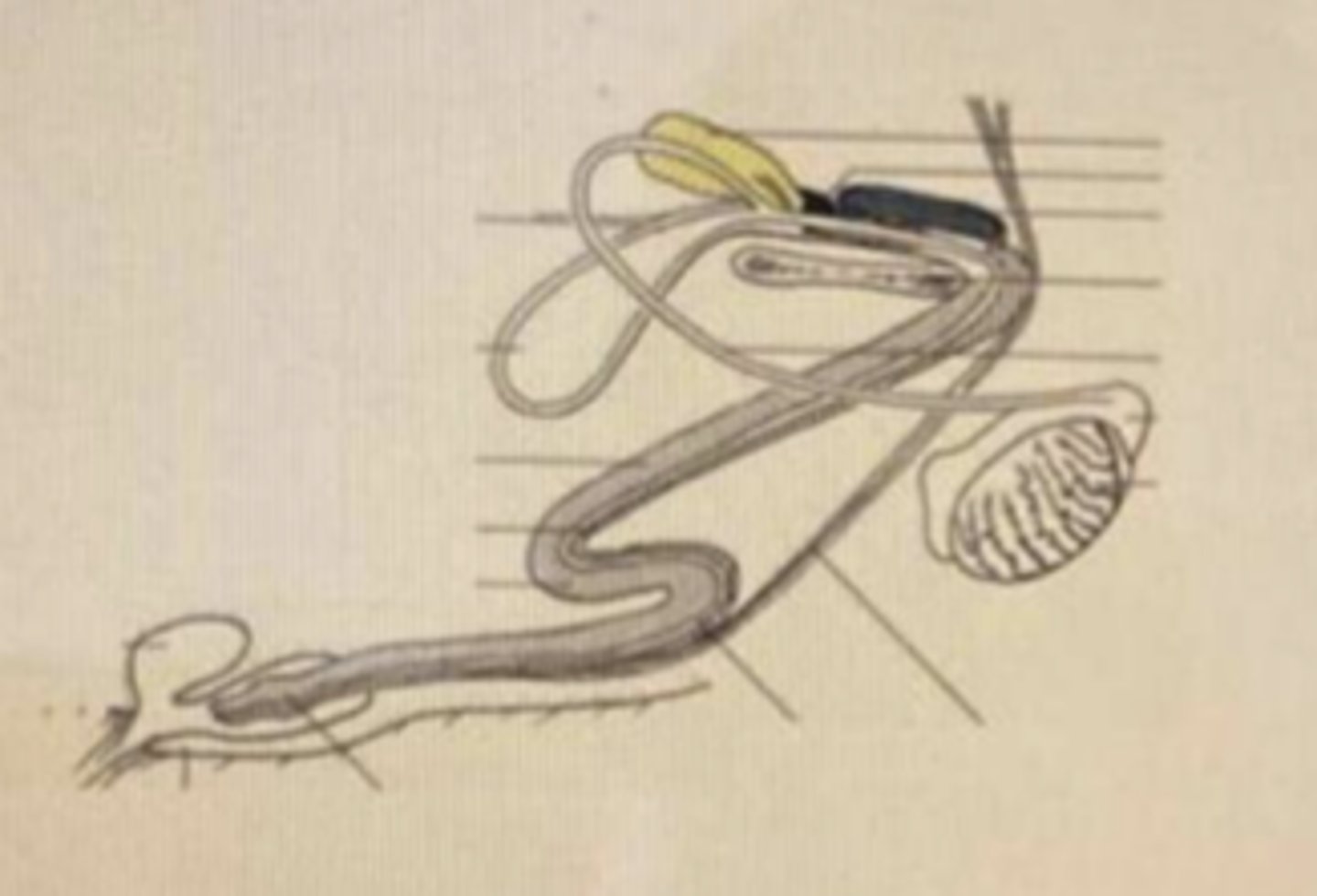
a
Which of the following statements about the ovarian cycle is correct?
a) The ovarian cycle is composed of a follicular and a luteal phase.
b) Ovulation occurs at the end of the luteal phase.
c) The follicular phase occurs after the luteal phase.
d) The luteal phase is when follicles grow and mature.
a
Which of the following statements regarding the testicles is incorrect?
a) The descent of the testicles happens before birth in all species.
b) The testicles are surrounded by a connective tissue capsule called the tunica albuginea.
c) The testicles descend through the inguinal canal.
d) The temperature of the testicles is lower than the body’s core temperature for proper spermatogenesis.
c
Which of the following statements is true?
a) The dog kidney is externally lobulated.
b) The pig kidney is unilobar and smooth like in dogs.
c) The bovine kidney does not have a renal pelvis.
d) The horse kidney is multilobar and externally lobulated.
a
Which of the following statements regarding hydrostatic pressure in the renal (Bowman's) capsule is incorrect?
a) It promotes the glomerular filtration.
b) It opposes the filtration pressure generated by the glomerular capillaries.
c) It is part of the forces opposing glomerular filtration, along with oncotic pressure.
d) It results from the fluid already filtered into the Bowman's space.
a
Which of the following statements about ADH (antidiuretic hormone) is incorrect?
a) It acts mainly on the level of the proximal glomerulus.
b) It increases water reabsorption in the collecting ducts.
c) It is released from the posterior pituitary gland.
d) It helps concentrate urine during dehydration.
c
Which of the following statements regarding testicular migration is incorrect?
a) Hormonal factors like testosterone and insulin-like peptide 3 influence testicular descent.
b) Testicular migration involves passage through the inguinal canal.
c) Testicular migration occurs during gestation in all species except the dog.
d) In dogs, testicular descent usually completes shortly after birth.
a
Regarding endocrine glands, which of the following statements is true?
a) The parathyroid glands are also called external parathyroids.
b) The adrenal cortex secretes adrenaline and noradrenaline.
c) The pituitary gland is located in the thoracic cavity.
d) The thyroid gland controls blood glucose through insulin release.
a
In which species is it easy to identify individual renal papillae in the kidney?
a) Pig
b) Dog
c) Horse
d) Sheep
c
Concerning glomerular filtration, which of the following statements is true?
a) The filtration barrier allows free passage of all plasma proteins.
b) Glomerular filtration removes red blood cells and large proteins from the bloodstream.
c) The filtrate is composed of all the elements of blood except blood cells, platelets, and proteins.
d) The filtrate contains only water and sodium ions.
b
In the fetus, what is the tube that connects the urinary bladder to the umbilical cord?
a) The allantois
b) The urachus
c) The urethra
d) The ductus venosus
b
What is the name of the region of the bladder located between the ureteral orifices and the internal urethral orifice?
a) Bladder apex
b) Trigone vesical
c) Ureterovesical junction
d) Detrusor zone
c
What is the part of the uterine tube that is closest to the ovary and receives the oocyte at the time of ovulation?
a) Ampulla
b) Isthmus
c) Infundibulum
d) Uterine horn
a
Which of the following statements regarding reproductive organs is incorrect?
a) The primordial ovarian follicle has cubic cells around the oocyte.
b) The uterus is composed of three main layers: endometrium, myometrium, and perimetrium.
c) Sertoli cells support and nourish developing sperm cells in the seminiferous tubules.
d) The epididymis stores and matures sperm after they leave the testis.
a
Which of the following statements is incorrect?
a) Cortisol is a mineralocorticosteroid that is produced in the zona fasciculata of the renal cortex.
b) Aldosterone is a mineralocorticoid secreted by the zona glomerulosa.
c) The adrenal cortex has three functional zones: glomerulosa, fasciculata, and reticularis.
d) Glucocorticoids are involved in metabolism and the stress response.
c
Which of the following statements about the postprandial (after eating) period is incorrect?
a) Glycogen synthesis is promoted in the liver.
b) Glucose uptake by tissues increases.
c) Lipolysis is increased.
d) Insulin secretion is stimulated.
a
Which of the following statements regarding the male reproductive organs is incorrect?
a) The prostate gland has simple cylindrical epithelium.
b) The epididymis plays a role in sperm maturation and storage.
c) Leydig cells in the testis produce testosterone.
d) The ductus deferens transports sperm from the epididymis to the urethra.
c
Which of the following is a correct statement about the effects of aldosterone?
a) It increases potassium reabsorption in the nephron.
b) It decreases blood volume and blood pressure.
c) It promotes the reabsorption of sodium back into the blood.
d) It inhibits sodium uptake in the distal tubules.
a
Which of the following statements about the adenohypophysis (anterior pituitary) is incorrect?
a) It is a direct continuation of the hypothalamus.
b) It originates from Rathke's pouch during embryonic development.
c) It secretes hormones like ACTH, TSH, and GH.
d) It is regulated by releasing and inhibiting hormones from the hypothalamus via the hypophyseal portal system.
d
Which of the following statements about the urinary apparatus is correct?
a) The loop of Henle is located entirely within the renal cortex.
b) The urethra connects each kidney to the urinary bladder.
c) The collecting ducts are part of the nephron.
d) The macula densa, element of the juxtaglomerular apparatus, in contact with the distal convoluted tubule and the afferent arteriole, has a cortical location.
d
Which accessory sex gland is present in male dogs?
a) All three glands are present in the dog
b) The seminal vesicles
c) The bulbourethral glands
d) The prostate gland
b
Which of the following is not a hormone secreted by the anterior pituitary (adenohypophysis)?
a) ACTH
b) ADH
c) FSH
d) GH
a
What is the name of structure number 3 (marked in green)?
a) Left kidney
b) Right adrenal gland
c) Spleen
d) Left ovary
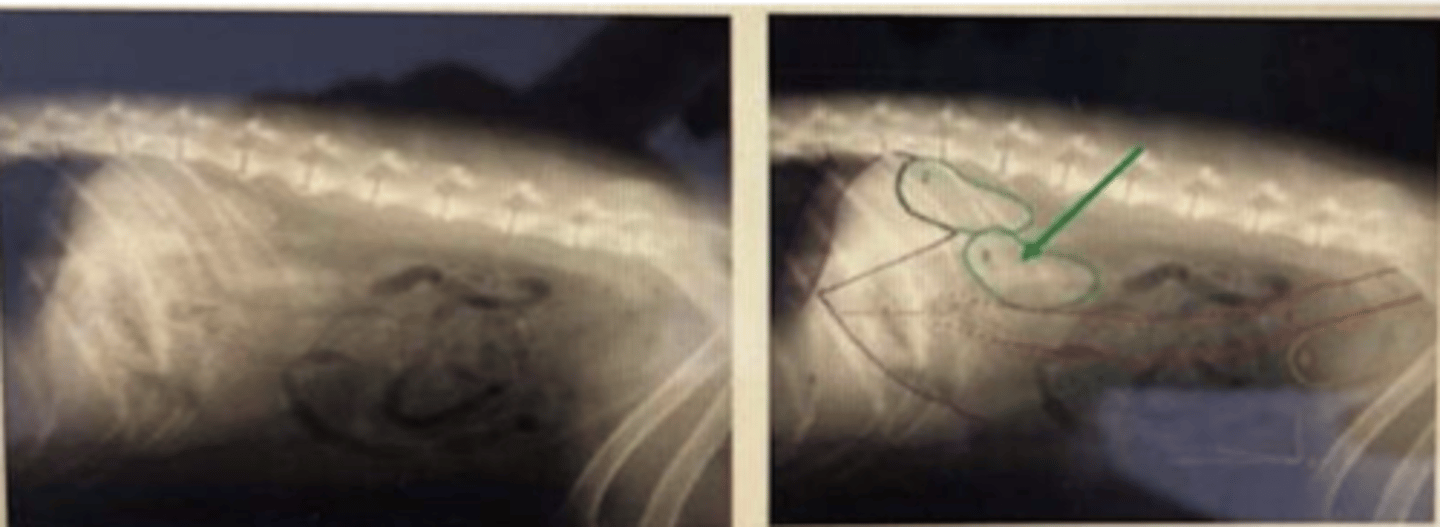
b
What structure is the arrow pointing to?
a) Rectum
b) Bladder
c) Prostate gland
d) Uterus
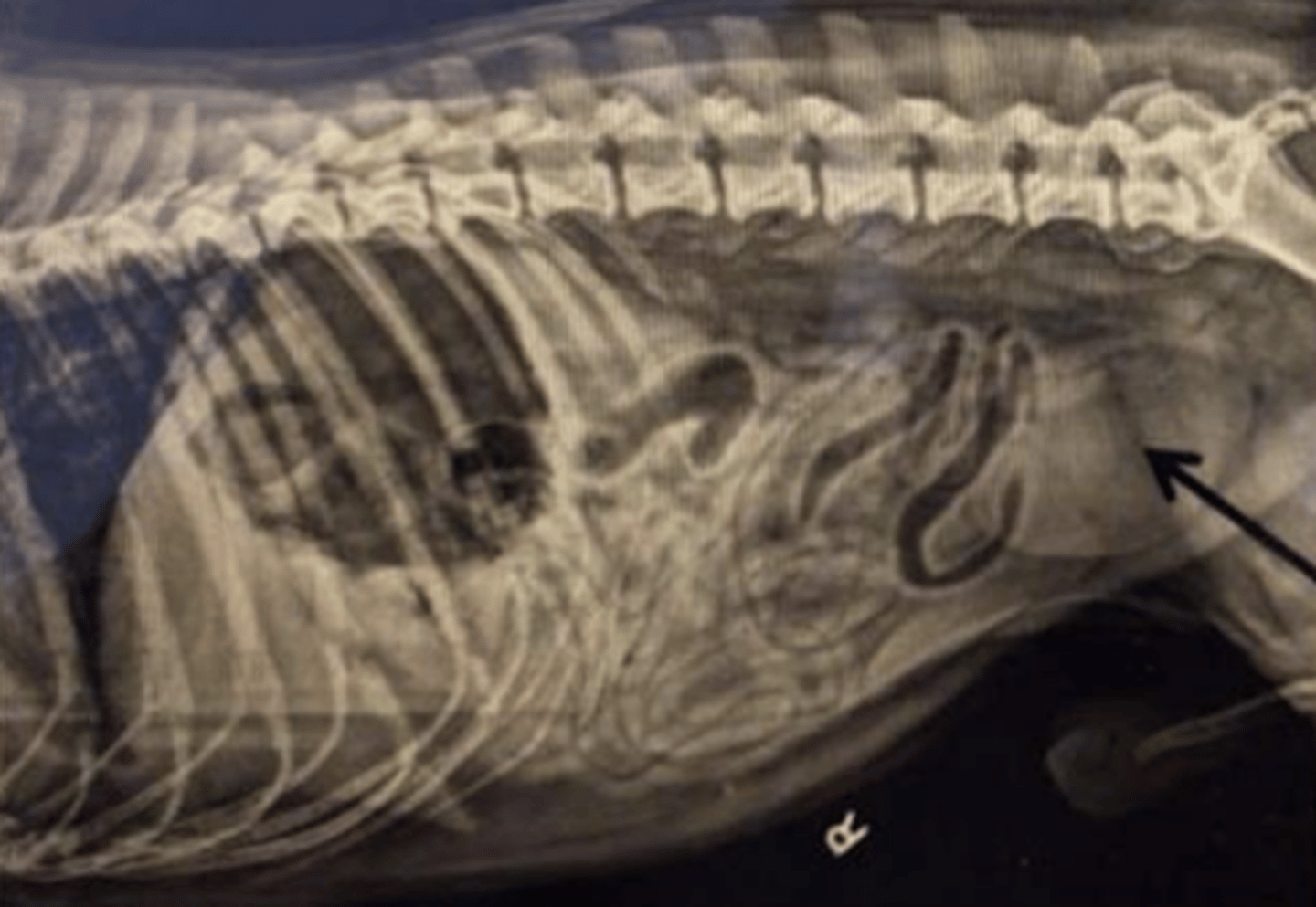
a
In the hypothalamic-pituitary-gonadal axis in males:
a. LH stimulates Leydig cells to produce Testosterone
b. LH stimulates FSH secretion in the hypothalamus
c. FSH is secreted in the neurohypophysis in response to LH
d. GnRH stimulates the anterior pituitary to produce testosterone
b
Low blood glucose levels typically result in the secretion of all the following except:
a. Glucagon
b. Alodsterone
c. GH
d. T4
a
Which of the following would result from a thyroidectomy (removal of thyroid)?
a. Increased TSH secretion
b. Decreased TSH secretion
c. Increased calcitonin secretion
d. Increased T3 and Thyroxine secretion
c
The macula densa detects________ stimulating secretion of _________
a. NaCl/ADH
b. H20/Aldosterone
c. NaCl/renin
a
What is the function of the principal cells on the cortical collecting tube?
a. Sodium reabsorption and potassium secretion
b. Potassium reabsorption and urea secretion
c. Water reabsorption and sodium secretion
d. Proton reabsorption and bicarbonate secretion
b
vThe thin descending loop of Henle is very permeable to:
a. Potassium
b. Water
c. Salt
d. Glucose
d
Which of the following endocrine organs is near the caudal vena cava?
a. Let adrenal gland
b. Right lobe of the thyroid gland
c. Left lobe of the thyroid gland
d. Right adrenal gland
d
Removal of the adenohypophysis would directly affect all except:
a. Mamary glands
b. Ovaries
c. Adrenal cortex
d. Adrenal Medulla
b
In the pancreas, ________ cells secrete glucagon which _______blood levels of glucose:
a. None of the options is correct
b. Alpha/ raises
c. Beta/ lowers
d. Delta/ raises
a
Increased reabsorption of water from kidneys is the major consequence of which
hormone?
a. Vasopressin
b. Insulin
c. Glucagon
d. Cortisol
b
Where in the renal tubule does the reabsorption of glucose take place?
a. Distal tubule
b. Proximal tubule
c. Proximal capsule
b
Which of the following metabolic effects would you suspect in a dog diagnosed to have
Acromegaly?
a. Decreased glucogenesis
b. Increased protein synthesis
c. Increased cholesterol synthesis
d. Decreased lipolysis
a
In which of these species is the mucularis of the mucosa of the urinary
bladder absent ?
a. Cat
b. Dog
c. Horse
d. Pig
d
Which of the following vessels drains into the left renal vein in carnivores?
a. Celiac vein
b. External iliac veins
c. Left cranial mesenteric vein
d. Left ovarian/testicular veins
b
Choose the correct number and location of the mammary glands depending on the specie:
a. Mare: 1 inguinal mammary gland
b. Cow: 4 inguinal mammary glands
c. Bitch: From 8-12 thoracic mammary glands
d. Small ruminants: 4 inguinal mammary glands
a
Which of the following is not produced by the pituitary gland?
a. GnRH
b. FSH
c. GH
d. ACTH
d
When nephrectomy must be carried out in a male dog, which of the following structures
must be sutured and where do we expect to find it?
a. Renal artery, renal vein and urethra. Lat. Surface kidney
b. Ovarian artery, ovarian vein and ureter. Lat. Surf. Kidney
c. Testicular artery, ovarian vein and urethra. Medial surface kidney
d. Renal artery, renal vein and ureter. Medial surface kidney
a
Incorrect answer regarding lymphoid organs:
a. The thymic involution generally begins after puberty.
b. The red bone marrow contains reticular cells, hematopoietic cells, macrophafes
and abundant capillaries.
c. In the bursa of Fabricious, the lymphoid follicles are located in the mucosa of the
organ.
d. In the lymph nodes and in the spleen the lymphoid follicles are mainly formed by B
Lymphocytes.
c
Which of the following is not a symptom of Hyperthyroidism ?
a. Increased appetite
b. Loss of weight
c. Increased ability to sleep
d. Increased heart rate
a
Choose the correct answer regarding the development of the urogenital system:
a. The mesonephros is replaced by the metanephros and gives rise to the deferent
duct and the epidydimis.
b. Cryptorchidism is the development of cysts in the testicles.
c. The pronephros is the most mature from of the kidney.
d. One example of an ectopic ureter is the opening of the ureter in the vagina
d
Regarding the events that occur during ovulation, choose the incorrect statement.
a. The stigma is formed.
b. The Graafian follicle pressures the tunica albuginea.
c. The mature follicles release the oocyte.
d. All answers are correct.
b
A tumor in the adrenal zona glomerulosa can cause hypersecretion of hormones produced
in that region. Which would you suspect to find in a patient with such a tumor?
a. Increased blood glucose levels
b. Increased blood sodium levels
c. Decreased blood calcium levels
d. Dehydration (water loss)
d
Which of the following hormones is not released by the same endocrine gland?
a. Adrenalin/Noradrenalin
b. Prolactin/GH
c. LH/FSH
d. CRH/ADH
c
Glomerular filtration rate decreases when:
a. The glomerular hydrostatic pressure increases.
b. The Bowmans capsule hydrostatic pressure decreases.
c. The glomerular oncotic pressure increases.
d. All answers are correct.
a
In males, FSH induces_________ cells, inducing production of __________
a. Sertoli/sperm
b. Sertoli/testosterone
c. Leydig/testosterone
d. Leydig/sperm
b
Which of the following hormones promotes hypoglycemia?
a. GH
b. Insulin
c. Epinephrine
d. Glucagon
d
A dietary deficiency of iodine would do which of the following?
a. Result in increased basal metabolic rate
b. Directly affect the synthesis of thyroglobulin
c. Result in decreased production of TRH
d. Result in increased production of TRH
b
Correct answer regarding the anatomy of the musculocavernous penis.
a. They are present in ruminants.
b. Cavernous bodies contain lots of vascular spaces and only small amounts of
connective tissue.
c. Erection takes place faster compared to fibroelastic penis.
d. They contain large amounts of connective tissue.
c
Ovulation occurs after:
a. Peak of Progesterone
b. Peak of LH
c. Peak of estrogens
d. Peak of oxytocine
b
Choose the correct answer regarding the broad ligament of the uterus:
a. It runs from the uterine horns to the ovary.
b. It is formed by the mesovarium, mesoalpinx & mesometrium.
c. It joins the ovaries to the ribs.
a
Which of the following ligaments fixes the urinary bladder to the floor of the abdominal
cavity?
a. Median ligament
b. Lateral ligament
c. Coronary ligament
d. Round ligament
a
In a ventrodorsal radiograph of the abdominal cavity in a dog, what is the structure the arrow is pointing at?
a) Renal vein
b) Ureter
c) Spleen
d) Pancreatic duct
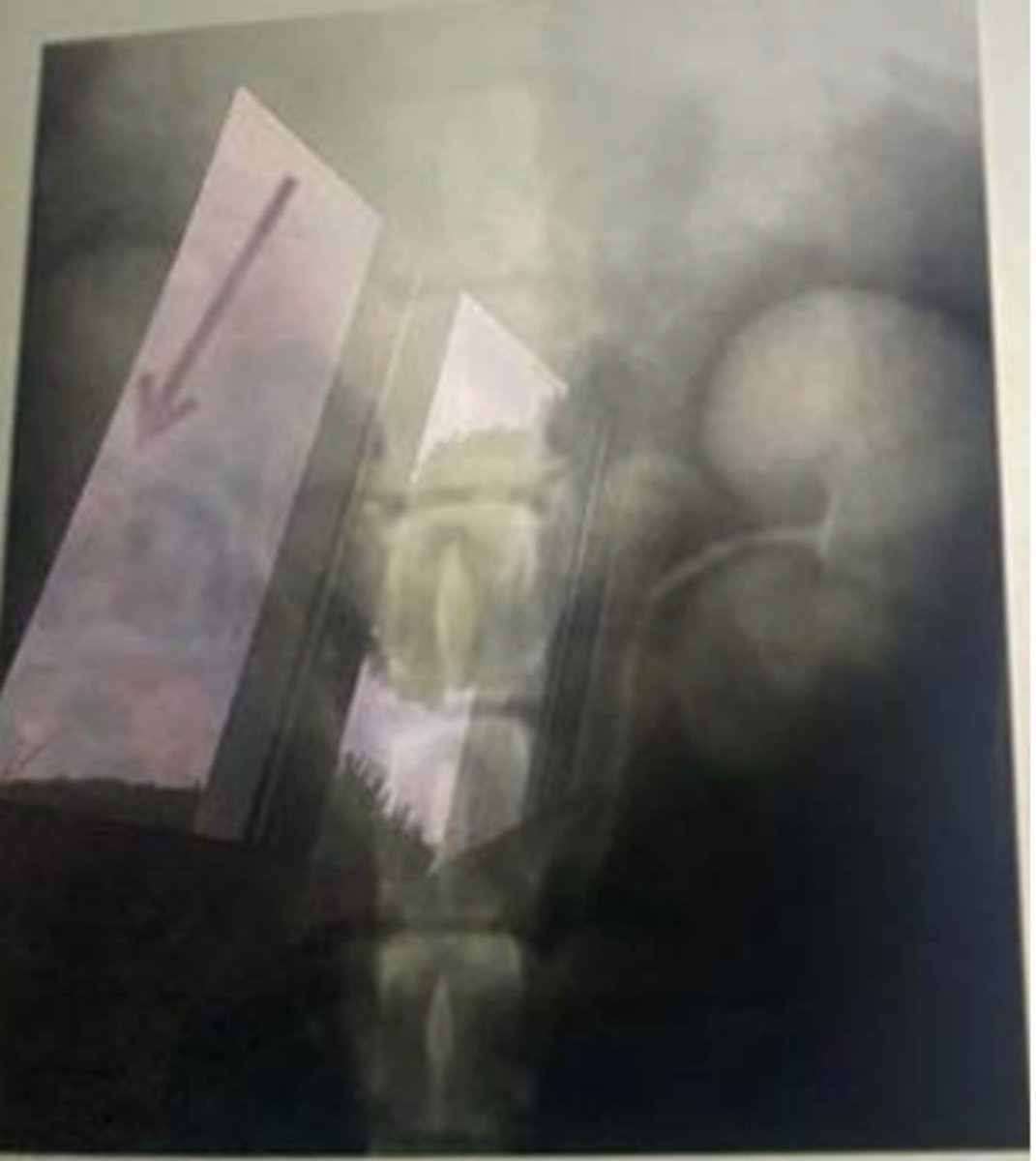
b
Which of the following species has smooth pluripapillary kidneys?
a. Small ruminants
b. Pigs
c. Carnivores
d. Equines
a
Choose the correct answer regarding kidneys.
a. The capillary endothelium of the renal glomerulus is fenestrated.
b. There are 2 layers involved in the glomerular filtration: the capillary endothelium
and the basal membrane.
c. The nephron is the functional unit of the kidney and it is exclusively located in the
renal cortex.
d. The Uriniferous tubule is formed by the nephron, the collecting duct and the renal
pelvis.
d
Which anatomic structure do we find in the renal hilium?
a. Renal artery
b. Renal vein
c. Ureter
d. All answers are correct
b
Estrus is characterized by:
a. Low estrogen levels inducing ovulation.
b. LH surge followed by ovulation.
c. Follicular growth.
d. Synthesis of progesterone by the corpus luteum.
b
Which of the following organs belongs to the intrathoracic portion of the abdominal cavity
in a dog?
a. Spleen
b. Liver
c. Urinary bladder
d. Kidneys
d
38. Which anatomic structure is the arrow pointing at?
a. Body of the uterus
b. Oviduct
c. Ovaries
d. Uterine horns
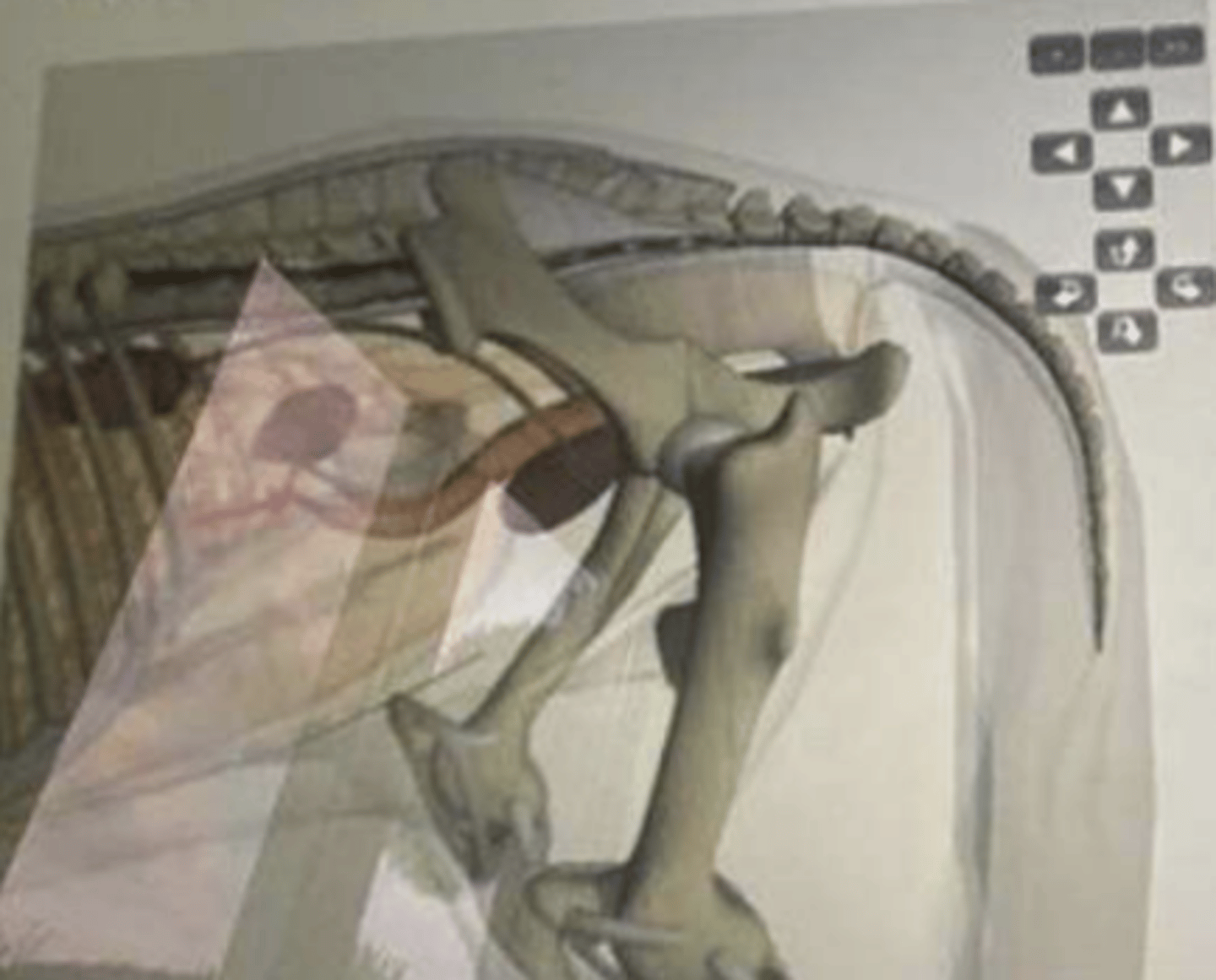
b
In the follicular phase, the early growing of the primary follicles are mainly stimulated by:
a. Estrogen
b. FSH
c. LH
d. Progesterone
b
Which specie?
a. Small ruminant
b. Equine
c. Large ruminant
d. Pig
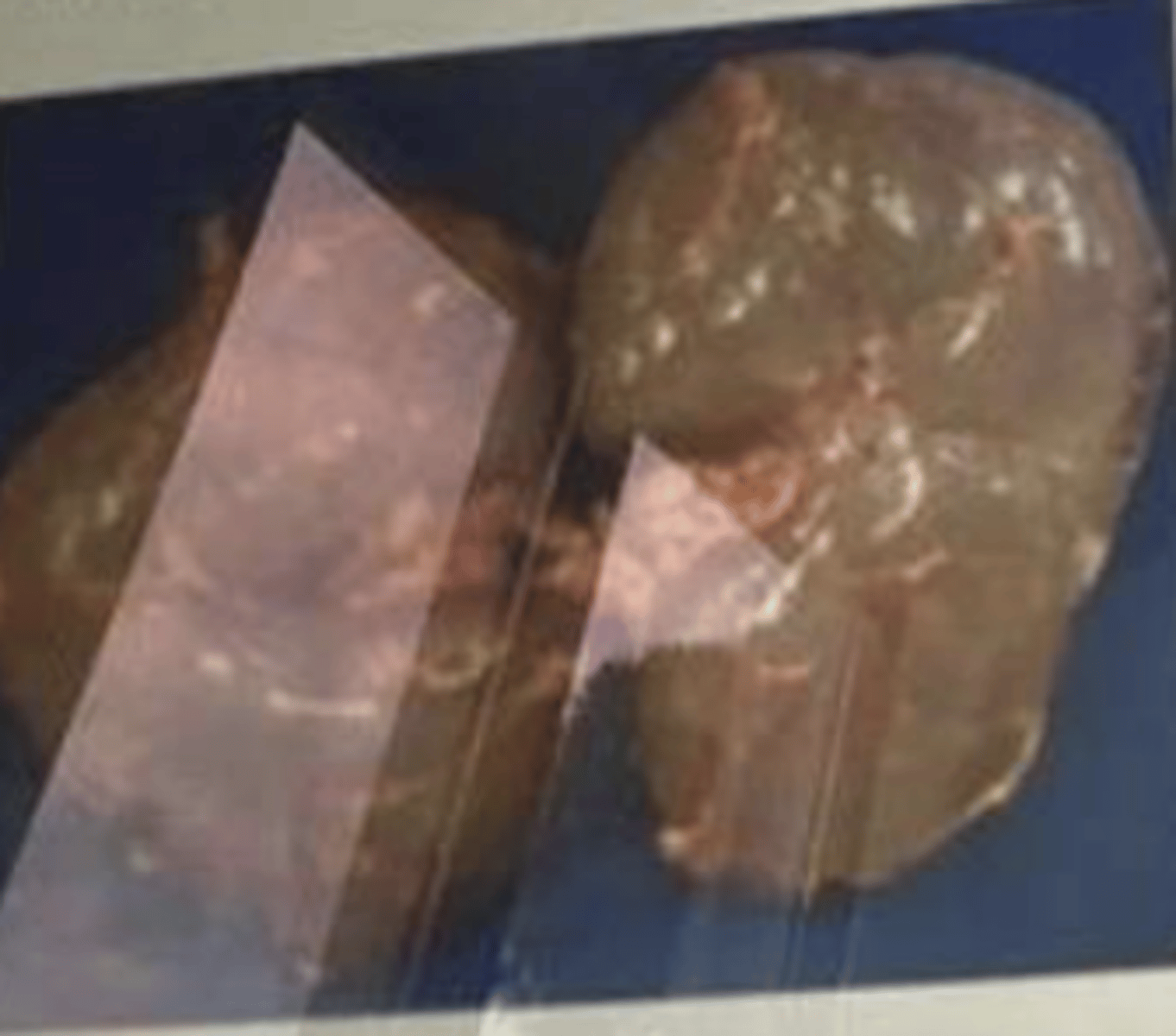
d
In which histological layer are the folds and crypts of the cervix located?
a. Serosa
b. Muscularis
c. Mucosa
d. Submucosa